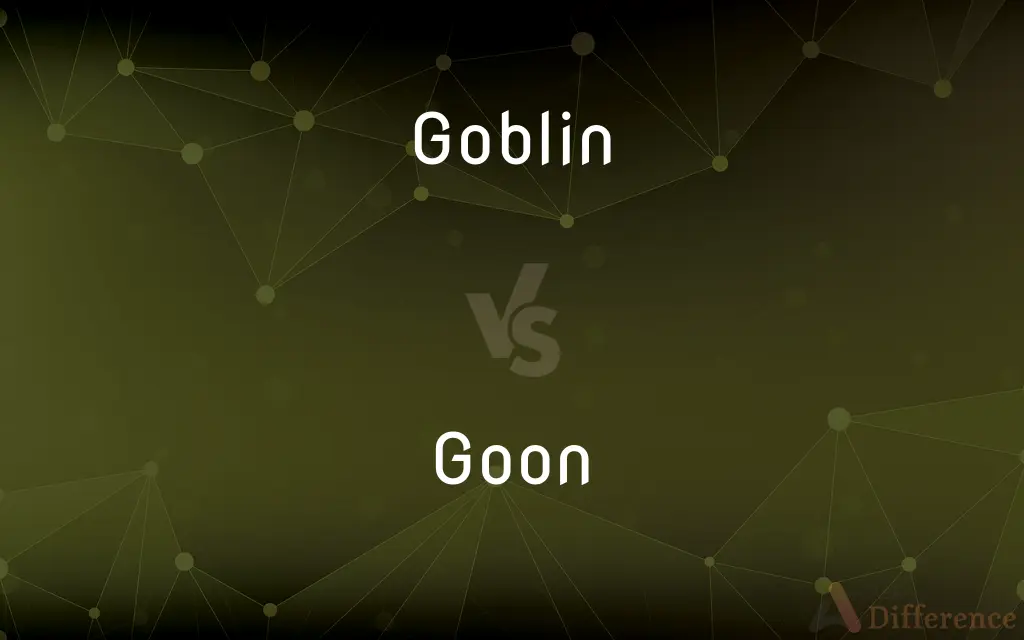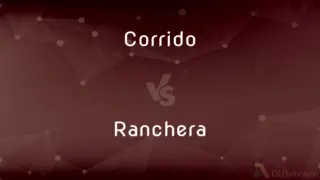Goblin vs. Goon — What's the Difference?
By Maham Liaqat & Urooj Arif — Updated on April 8, 2024
Goblins are mythical creatures known for mischief and malice, often depicted in folklore, whereas goons are real, typically described as hired thugs or bullies.

Difference Between Goblin and Goon
Table of Contents
ADVERTISEMENT
Key Differences
Goblins are fantastical beings from folklore, characterized by their mischievous and sometimes malevolent behavior. They are often depicted as small, grotesque creatures with a penchant for trouble and magical abilities, varying widely across different cultures' myths. On the other hand, goons are real-life individuals, usually employed to intimidate or commit acts of violence. They are often associated with criminal activities and are employed as enforcers or thugs by organizations or individuals seeking to assert power through fear and aggression.
While goblins are imagined entities with roots in ancient storytelling, playing various roles ranging from harmless pranksters to dangerous adversaries, goons are a modern reality, embodying the darker aspects of societal conflicts and criminal enterprises. Whereas goblins can represent the unknown, embodying natural human fears of the dark and the supernatural, goons represent the tangible threat of violence in social and political disputes.
The concept of a goblin is flexible, with its characteristics and intentions changing depending on the cultural context; some are seen as evil, others as simply tricksters. In contrast, the role of a goon is fairly consistent, being an individual who uses intimidation and physical force for coercion or enforcement, often without the nuances of moral ambiguity that mythical creatures might possess.
Goblins, being mythical, allow for a wide range of artistic and literary interpretations, serving as villains, comic relief, or even sympathetic characters in stories and media. Goons, however, are depicted in media in a more straightforward manner, often as antagonists or obstacles, with less emphasis on depth of character or motivation beyond their role as muscle for hire.
The societal impact of these two concepts is also markedly different. Tales of goblins can teach lessons, entertain, or frighten, contributing to cultural heritage and the collective imagination. Conversely, the presence of goons in society highlights issues of lawlessness, exploitation, and the exercise of power through fear, often prompting discussions about law enforcement, social justice, and personal safety.
ADVERTISEMENT
Comparison Chart
Nature
Mythical creature
Real-life individual
Origin
Folklore and mythology
20th-century slang
Role
Mischief-maker, sometimes malevolent
Hired thug or enforcer
Cultural Impact
Part of cultural storytelling, varying roles
Associated with crime and violence
Representation
Varied across cultures, often magical
Consistently negative, lacking magical or supernatural aspects
Compare with Definitions
Goblin
A mischievous and malevolent mythical creature.
The children were terrified by stories of a goblin hiding in the woods.
Goon
A hired thug or bully, often involved in criminal activities.
The businessman employed goons to intimidate his rivals.
Goblin
Often depicted as small and grotesque.
In the tale, the goblin had sharp teeth and pointed ears.
Goon
Often lacks a nuanced character in stories, depicted as muscle for hire.
In the movie, the hero had to fight his way past the villain's goons.
Goblin
Known for their trickery and magical abilities.
The goblin used its magic to vanish before being caught.
Goon
Used to describe someone who uses brute force or intimidation.
The goons at the club entrance made sure there was no trouble.
Goblin
Features in myths and stories across various cultures.
Each culture has its own version of a goblin, from mischievous spirits to guardians of treasures.
Goon
Associated with protection rackets and enforcement.
Local shopkeepers were harassed by goons demanding protection money.
Goblin
Can be benign or malevolent, depending on the folklore.
The village goblin helped lost travelers in exchange for gifts.
Goon
Reflects societal issues of violence and lawlessness.
The increase in goon activity in the area has raised concerns about safety.
Goblin
A goblin is a monstrous creature that appears in the folklore of multiple European cultures, first attested in stories from the Middle Ages. They are ascribed various and conflicting abilities, temperaments and appearances depending on the story and country of origin.
Goon
A thug hired to intimidate or harm opponents.
Goblin
A grotesque elfin creature of folklore, thought to work mischief or evil.
Goon
A stupid or oafish person.
Goblin
One of various hostile supernatural creatures, now especially (fantasy literature) a malevolent and grotesque diminutive humanoid, often associated with orcs or trolls.
Goon
A thug; a usually muscular henchman with little intelligence.
Goblin
An evil or mischievous spirit; a playful or malicious elf; a frightful phantom; a gnome.
To whom the goblin, full of wrath, replied.
Goon
A fool; someone who is silly, stupid, awkward, or outlandish.
Goblin
(folklore) a small grotesque supernatural creature that makes trouble for human beings
Goon
An enforcer or fighter.
Goon
A German guard in a prisoner-of-war camp.
Goon
(slang) One hired to legally kidnap a child and forcibly transport them to a boot camp, boarding school, wilderness therapy, or a similar rehabilitation facility.
Goon
(internet slang) A member of the comedy web site Something Awful.
Goon
A wine flagon or cask.
Goon
Cheap or inferior cask wine.
Goon
A Sino-Japanese kanji pronunciation layer, considered the first Sino-Japanese kanji reading type imported into Japan.
Goon
To act like a goon; to act in an intimidating or aggressive way towards opponents.
Goon
(neologism) To legally kidnap a child and forcibly transport them to a boot camp, boarding school, wilderness therapy, or a similar rehabilitation facility.
Goon
An awkward stupid person
Goon
An aggressive and violent young criminal
Common Curiosities
What does goon mean?
Goon commonly refers to a hired thug or bully, used for intimidation or violence.
Are goblins considered evil?
Goblins can be depicted as evil, mischievous, or even benign, depending on the story or cultural context.
How do goblins appear in folklore?
Goblins are depicted in various ways across different cultures, often as small, magical creatures with a propensity for causing trouble.
What kind of activities do goons engage in?
Goons may engage in intimidation, protection rackets, violence, and other criminal activities.
What is the origin of the term "goon"?
The term "goon" originated in the early 20th century, initially used to describe a foolish or simple person, later evolving to mean a thug or henchman.
Why are goons employed?
Goons are typically employed to exert force, intimidate, or commit acts of violence for someone else's benefit.
Can goblins be good?
In some stories, goblins are portrayed positively, helping humans or performing good deeds.
What is a goblin?
A goblin is a mythical creature often portrayed as mischievous or malevolent, appearing in various cultures' folklore.
Is the concept of a goblin universal?
While many cultures have creatures similar to goblins, their characteristics, and roles vary widely.
Can goblins speak?
In many stories and myths, goblins are capable of speech, often using their ability to deceive or bargain with humans.
Are goblins part of religious beliefs?
Generally, goblins are not part of formal religious beliefs but are common in folklore and mythological stories.
Do goblins have powers?
Many depictions of goblins attribute them with magical powers or abilities, ranging from shape-shifting to invisibility.
How are goons portrayed in media?
In media, goons are often portrayed negatively, as mindless enforcers or muscle for villains.
What is the difference between a goon and a bodyguard?
The key difference lies in their methods and purposes; bodyguards protect, often lawfully, while goons typically use unlawful violence or intimidation.
Are there female goons?
Yes, while less commonly depicted, female goons or enforcers also exist in reality and fiction.
Share Your Discovery

Previous Comparison
Consultation vs. Interview
Next Comparison
Corrido vs. RancheraAuthor Spotlight
Written by
Maham LiaqatCo-written by
Urooj ArifUrooj is a skilled content writer at Ask Difference, known for her exceptional ability to simplify complex topics into engaging and informative content. With a passion for research and a flair for clear, concise writing, she consistently delivers articles that resonate with our diverse audience.
















































